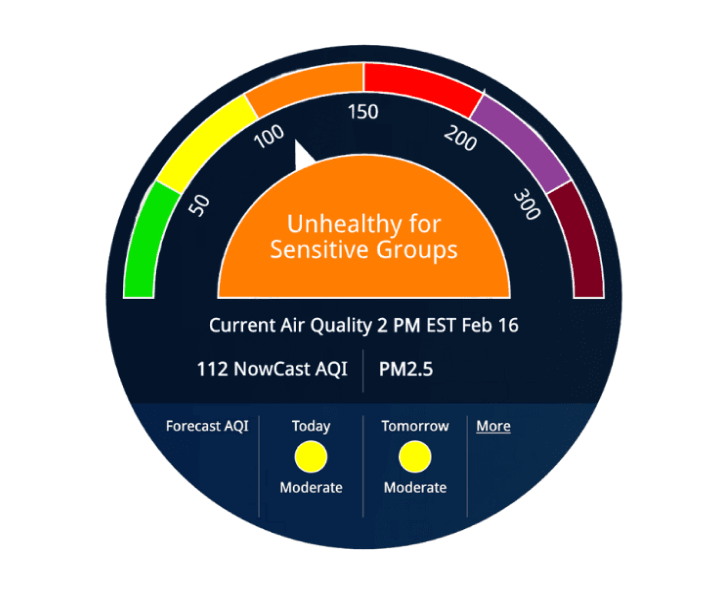
Understanding the Air Quality Index
Air Quality Index (AQI) measures the air quality in ranges from 0 to 500.
The higher the level of air pollution, the higher the AQI.

Air Quality Index (AQI)
The AQI meter displays a couple of useful metrics. The first type of information shown is the air quality. This is represented by both a number, 0-300 and a corresponding color. The chart below describes the meaning of the numbers and their colors as they relate to the AQI. In the example above, the AQI rating is 112, orange, which is considered unhealthy for sensitive groups.
AQI
Good (green)
0-50
Air quality is satisfactory and air pollution causes little or no risk.
Moderate (yellow)
51-100
Air quality is acceptable; however, there may be a risk for some people, particularly those who are unusually sensitive to air pollution.
Unhealthy for Sensitive Groups (orange)
101-150
Members of sensitive groups may experience health effects. The general public is less likely to be affected.
Unhealthy (red)
151-200
Members of sensitive groups may experience health effects. The general public is less likely to be affected.
Very Unhealthy (purple)
201-300
Health alert: The risk of health effects is increased for everyone.
Hazardous (maroon)
301+
Health warning of emergency conditions; everyone is more likely to be affected.
Pollutants
The second metric on the AQI meter is the pollutant indicator, with the pollutant code displayed below the date and time. The chart below shows the pollutants.
03 — Ground-level ozone
The most at-risk group includes people with lung disease, children, older adults, people who are active outdoors, people with certain genetic variants, and people with limited intake of certain nutrients.
PM 2.5 — Particle matter
Particles that have diameters of 2.5 micrometers or less. Most at-risk groups include people with heart or lung disease, older adults, and children.
PM 10 — Particle matter
Particles that have diameters of 10 micrometers or less. Most at-risk groups include people with heart or lunch disease, older adults, and children.
CO — Carbon monoxide
The most at-risk group is people with heart disease.
S02 — Sulfur dioxide
Most at-risk groups include people with asthma, children, and older adults.
N02 — Nitrogen dioxide
Most at-risk groups include people with asthma, children, and older adults.
13 Offices to Choose From
Find the location most convenient for you. We’ll see you there!
Hanford
1560 W. Lacey Blvd. #103
Hanford, CA 93230
Phone: 559-582-8500
Visalia
5410 W. Cypress Ave, Suite 102
Visalia, CA 93277
Phone: 559-713-1600
Madera
2311 W. Cleveland Ave, Suite 1
Madera, CA 93637
Phone: 559-674-0075
Los Banos
1415 Badger Flat Road, Suite A
Los Banos, CA 93635
Phone: 209-710-8684
Merced
360 E Yosemite Ave, Suite 200
Merced, CA 95340
Phone: 209-354-4675
Modesto
1923 Coffee Road, Suite 12C
Modesto, CA 95355
Phone: 209-409-8454
Clovis
2021 Herndon Ave, Suite 102
Clovis, CA 93611
Phone: 559-472-3116
Fresno – Clovis Ave
505 N. Clovis Avenue
Fresno, CA 93727
Phone: 559-981-5040
Fresno – Milburn Ave
6643 N. Milburn Ave. Suite 101
Fresno, CA 93722
Phone: 559-275-1400
Fresno – Main Office
7471 North Fresno Street
Fresno, CA 93720
Phone: 559-436-4500
